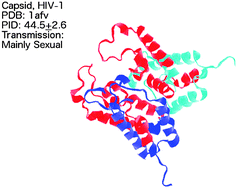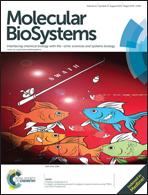Shell disorder, immune evasion and transmission behaviors among human and animal retroviruses
Abstract
This study involves measurements of percentages of intrinsic disorder (PIDs) in the GAG protein shells of various retroviruses. Unique patterns of shell protein disorder can be seen especially when GAG proteins (matrix M, capsid C, and nucleocapsid N) of primate and non-primate retroviruses are compared. HIV-1 presents the most unique pattern of disorder distribution with generally high levels of disorder in all three proteins, while EIAV (PIDs:: 26, 29, 13) is diametrically different from HIV-1 (N C M PIDs: 39.5 ± 3.0, 44.5 ± 2.6, 56.5 ± 10.8). The HTLV viruses (CPID: 32.8 ± 3.4) resemble HIV-2 (C PID: 26.6 ± 2.9) with a moderately disordered capsid. Totally distinct patterns, however, are seen for the non-primate retroviruses. They generally have highly disordered nucleocapsids (PID > 65%) and more ordered outer shells especially the matrix. These characteristics might be attributed to the differences in the way the retroviruses are transmitted, with non-primate viruses having greater non-sexual transmission components such as oral-fecal transmission. These differences are also evolutionarily related to the ways the viruses evade the host immune systems, and thus, have implications for oncolytic virotherapy and animal models in vaccine research. The importance of protein shell disorder in immune evasion, as related to the case of HIV-1, and the difficult search for its vaccines are highlighted.


 Please wait while we load your content...
Please wait while we load your content...